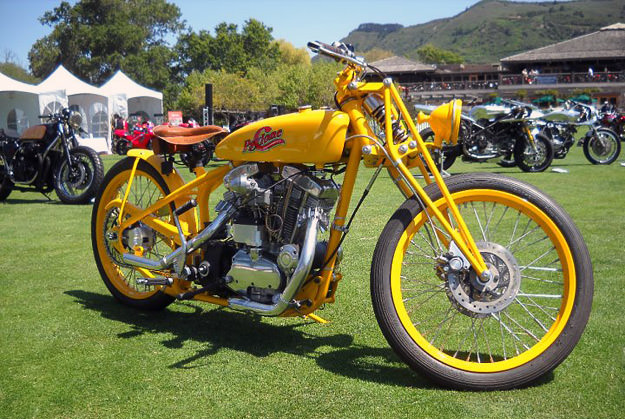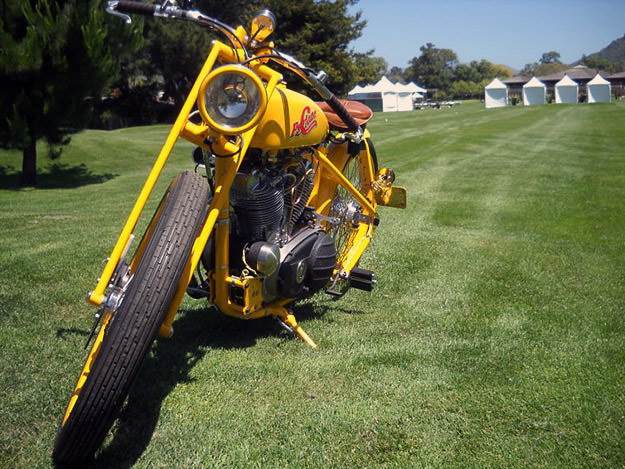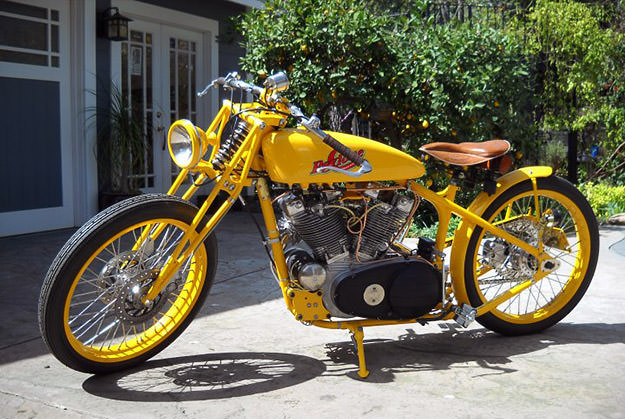
Frederick Fortune is a graphic designer in the San Francisco bay area with a passion for motorcycles. He sent in this story about his amazing replica of the Cyclone board track racer. The real thing is worth around half a million dollars: this is the tale of a man who decided to build one himself.
“Forget it, you can’t have one.”
This wifely advice was delivered to me while standing awestruck in front of one of eight remaining Cyclone board track racers at the 2005 Guggenheim Art of the Motorcycle exhibit at Las Vegas’ over-the-top Bellagio Hotel.
No kidding I can’t have one, I agreed silently. Scratching through my dim memory I seem to recall decomposing barn find board track racers going for well north of $40k, restored versions twice and three times that. Lord knows what this pristine yellow jewel with all its polished nickel screw heads perfectly lined up is worth.
It has a certain stance I thought, screaming, “look at me”, every inch coated in a rich getouttamyway yellow. Not the flaccid yellow of fresh creamery butter, but the screaming yellow zonkers yellow of a school bus loaded with a squad of virgin cheerleaders plunging off a cliff. It glowed and seemed to struggle, trying to rip itself up and away from the stainless cable harness confining it to the mirrored display top.
The motorcycle visually lunging at me was one of the fastest, most amazing motorcycles of its day, a 1915 Cyclone racer. In its trademark yellow livery, it was the fastest thing on two wheels, and by all accounts living or dead, unquestionably the epitome of the breed. For some reason, long after the last dust clouds settled and the last oil fumes dissipated, old-timers and modern enthusiasts alike would speak lovingly and endlessly of the bike I was now absorbing through every exposed orifice. Its reputation is amazing, considering it was made and raced for only three short years.
In 1912 the five men comprising the Joerns Motorcycle Manufacturing Company of St. Paul, Minn. began building a most radical motorcycle. What they (and motor designer Andrew Strand) came up with was for a short time the fastest thing on two wheels. Why?
The five company owners had little knowledge of, or interest in, issues regarding marketing, dealers and service—and it showed in the company’s lack of longevity. They had no problem with manufacturing and material quality. However, production was slow and expensive. Profits were minimal, and as a result production stopped in 1915 after no more than 300 Cyclones had been built.
Its meteoric rise and fall could be attributed to one thing only: its amazing motor. The Cyclone was powered by a revolutionary bevel gear driven double overhead cam motor that went like stink. This is in 1912, when state of the art was flatheads with atmospheric intakes.
Besides the overhead cams, there were other technological applications that were unheard of in the day… like demountable cylinder heads on steel cylinders splayed at 75 degrees and mounted on an aluminum crankcase. Roller bearings were used throughout, and machine clearances were held to tolerances only grudgingly accepted many decades later.
But despite all the technology, a simple engineering oversight was the machine’s downfall. Discovered decades later by a virtually unknown vintage restorer, it was learned that the motors’ flywheels had an inherent, built-in imbalance which—if didn’t crack the frame—would grenade the motor. Both happened, and frequently.
Yet while they did run they were untouchable. Consider near 50 horsepower at 5,000 RPM (astronomical for 1912) in essentially a bicycle frame. Consider this vehicle on an oval mile of wood 2 x 4s on edge, traversing its entirety in 35 and 2/5ths seconds. (Put down your calculator, that’s 101mph.) Top speed was reputed to be a whisker shy of 111 miles per hour.
Imagine this bike neck and neck with 10 or 15 other spindly racers on a splintered, oil-slick wooden board track. Constant loss oiling, remember? Watch these turn-of-the-century speed demons do major damage to themselves and, often, spectators. Their machines had no brakes and in several instances including the Cyclone, speed was controlled only by an off/on kill switch. Safety equipment was nonexistent; cloth caps were worn as headgear, leathers were uncommon, and riders wore everyday shoes.
Dangerous, yes. Gorgeous, absolutely. And that amazing yellow. Of course, I had to have one. One problem… of the eight Cyclone racers believed to still exist, the last one was auctioned for a record $530,000.
Whoops… well, what next? Let’s see… I had earlier acquired a 900cc 1964 ironhead Sportster motor from dear friend sportstergoddess Diana Pettijohn’s dusty garage shelf, originally intended for a stillborn project, which she had conveniently succeeded in having completely rebuilt, drain plug to rockerbox bolts by one of California’s legendary Sportster flathead, XR750 and XR1000 racing wizards Duncan Keller. Now I had a vintage appearing v-twin… good start.
So the challenge begins. Now we need forks and a frame that exhibit the characteristics of these century-old racers… so girder forks. Yep, here’s something from Donnie Smith that will pass if one squints while standing on one leg. Even comes with an adjustable Progressive shock, perfect. Plus available in stock Sportster length so I don’t have to bone up on frame rake and trail engineering. Done.

Next the frame. Shy of multi thousands of $ and lacking the skills not to mention the tools to fabricate same, I came across a single front downtube rigid frame that would accept a Sportster motor with minor jiggling. Also available with stock rake and no stretch. Better and better. Thank you Carolina Customs.
OK, first problem… the frame comes designed for a completely anachronistic 280ish rear tire and de rigueur low slung saddle. Realizing we need serious help here, we turn to motorcycle racing frame and suspension genius and friend James Banke of Banke Performance (Felton, California) for some judicious slimming of the rigid rear frame forks and addition of a bicycle style seat post. Done.
Characteristic of the breed, besides skeletal frame and forks, are tall skinny tires. So what’s reasonable and easily available rim and tire wise… yep, 21” rims and only the best will do. So two alloy 40-spoke shoulderless rims from Excel are ordered, with two sets of stainless spokes from Buchanon. Avon Speedmasters and heavy-duty tubes are acquired and mounted.
If you look at the original racer you’ll notice it has no brakes. Somewhat unsafe in modern times, so I opted for the feature. But which? And how? What minimal, visually unobtrusive mechanism could I find for, again, a reasonable cost. Solution: Hawg Halter’s combination rear disk brake rotor and sprocket for the back: it mates bolt-for-bolt to a 2006 Sportster front hub, soon to be laced into one of the previously mentioned 21” alloys. Back is done.
Front next. Scratched off the list without a second thought were those elegant hub brakes by 360 Brake. We’re on a budget here, so next best thing were two of the smallest rotors and calipers I could find. The solution was rear rotors from a Buell Blast and tiny single puck Grimeca calipers from the rear of a Gas Gas Trials Bike, perfect. Small, powerful, minimalistic.
Making it work sees Banke again to the rescue, magic-ing the rotors onto either side of an orphaned 40-spoke alloy racing hub found in his parts bin and mounting the calipers almost invisibly to the inside of the girder forks. The rear brake is actuated by a Triumph master cylinder mounted transversely to the rear down tube, just above the transmission. The front actuator assembly was trickier because I wanted to use my Chinese clone of a Russian clone of a prewar German BMW reverse control handlebar assembly that I scored on eBay. So now the hunt was on for a cable operated, dual hydraulic master cylinder with a remote reservoir. And Eureka… such a beast exists under the toaster tank of certain 80s vintage BMW touring motorcycles. One was found, rebuilt and voila… brakes.
OK, we have GO and STOP and something to hang it all on. Next we need to look closer at our model and start making this look more like the real deal. First off was an easy one… and satisfied by a lucky find: an extremely narrow bobbed rear fender from a Triumph side car and run through a beading die to make a flat rib like the original. Widened rear fender struts from the front of an early Norton roadster were donated to the cause by noted vintage Norton restorer Ken Armann Classic Motorcycle Restoration & Repair. Next a saddle maker was found in Texas who makes recreations of the vintage leather covered, split wood base racing saddles… Larry Heilman, and ordered. It was mounted on a home-brew parkerized spring seat frame from a 1916 Schwinn Motobike. Ebay again.
Most expensive is the most important, the fuel/oil tank. Shape was critical; also critical was that it also needed to encompass the oil reservoir. No other was trusted than master Ukiah metalsmith Evan Wilcox. The results are stunning. Oil is contained in an inner box living inside the left side of the tank. Gas surrounds and cools it, a technique used in early motorcycles from Excelsior to Indian. Hiding the oil reservoir kept the bike visually open and true to the original.
Now we’re down to the short strokes. Well, still long, but shortening. Front lighting is satisfied by a spotlight from a 1915 firetruck mounted on a heavily modified lower fork component, the original 9 volt bulb swapped out for 12 volt. The rear lamp is a remanufactured Vincent item mounted on a homemade sheet brass frame and bracket assembly. Footpegs are Harley kickstart pedals mounted on Buell folding clevis mounts for that period bicycle look.
Incidentally the pegs are mounted relative to the seat and bar ends, with similar ergonomics to my Norton Commando. Serendipitously the modified and backwards flipped shift lever gives the identical one-up and three-down right foot shift pattern of the Norton which made a short learning curve when the yellow racer finally hit the street. For a modicum of safety an early Ducati chain guard was selected and mounted, a small digital tach was ordered, its mounting bracket hand fabricated.
Now it’s time for teardown, finishes and all the fiddly bits. The pristine, virgin 1964 Sportster motor was torn down, top end only. The heads and cylinders, headers, and Triumph finned header clamps were sent out for high temp “near chrome” powdercoating. This gives a silvery, bulletproof coating that looks like polished nickel, which further helps nail the all-silver look of the original Cyclone motor. A Linkert DC-12 carburetor was found and rebuilt by Linkertcarbs.com of Wyoming. A Joe Hunt rare earth magnet magneto was ordered and delivered. The rear sprocket cover and cam chest I cut down and had powdercoated in a specifc pattern to help disguise the characteristic Sportster silhouette, as was the tin primary cover. All chrome I scotchbrighted to a satiny, brushed stainless appearance. All fasteners are stainless, with the marks on the bolt heads ground off and polished.
Near-chrome ceramic coatings as well as fork, frame and bracketry, rims powdercoating were brilliantly done by Spray Technologies of Santa Clara, California. Powdercoated rims and polished hubs were returned to Banke for relacing. Aptos, California’s Joe the Bike Painter matched the buttercup yellow for the tank and fender dead nuts. And my Psyclone design was printed digitally on thin film adhesive and ended up flawlessly under Joe’s miles deep clear coat.
While local ironhead guru Paul Hudson R&R’d the top end with the new ceramic pieces, a contemporary version of cloth coated wire was found, inner plastic-sheathed, and a wiring harness designed for batteryless operation, horn and lights running briefly off a hidden capacitor. The junction block and tach trigger are hidden under the tank next to the master cylinder. Old style metal cable ties were used when wiring could not be hidden in the frame, all terminals soldered and shrink tubed. Oil lines were first mocked up with heavy wire, and the shapes transferred to ¼ copper tubing. For a quick disconnect period look, all the connections are safety wired oil-resistant tubing.
Did I come close to the original? I think so, but you are the judge. Total parts, machine work, coatings and materials came to just under $12,000. Beats a cool half million any day and I had a blast building it.
